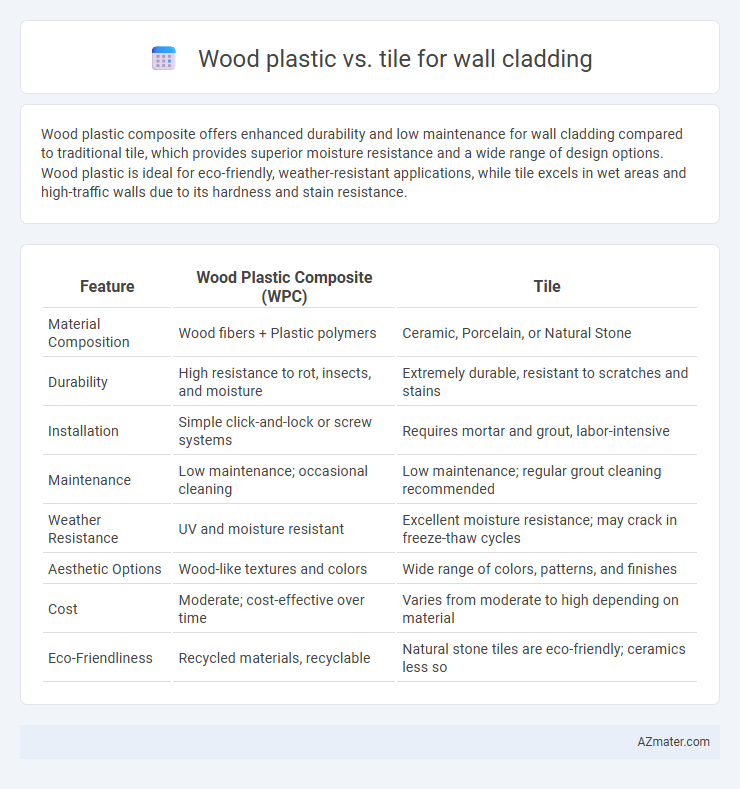Wood plastic composite offers enhanced durability and low maintenance for wall cladding compared to traditional tile, which provides superior moisture resistance and a wide range of design options. Wood plastic is ideal for eco-friendly, weather-resistant applications, while tile excels in wet areas and high-traffic walls due to its hardness and stain resistance.
Table of Comparison
| Feature | Wood Plastic Composite (WPC) | Tile |
|---|---|---|
| Material Composition | Wood fibers + Plastic polymers | Ceramic, Porcelain, or Natural Stone |
| Durability | High resistance to rot, insects, and moisture | Extremely durable, resistant to scratches and stains |
| Installation | Simple click-and-lock or screw systems | Requires mortar and grout, labor-intensive |
| Maintenance | Low maintenance; occasional cleaning | Low maintenance; regular grout cleaning recommended |
| Weather Resistance | UV and moisture resistant | Excellent moisture resistance; may crack in freeze-thaw cycles |
| Aesthetic Options | Wood-like textures and colors | Wide range of colors, patterns, and finishes |
| Cost | Moderate; cost-effective over time | Varies from moderate to high depending on material |
| Eco-Friendliness | Recycled materials, recyclable | Natural stone tiles are eco-friendly; ceramics less so |
Introduction to Wall Cladding Options
Wood plastic composite (WPC) and tile represent two prominent wall cladding options offering distinct benefits for exterior and interior surfaces. WPC combines the natural aesthetics of wood with the durability and low maintenance of plastic, providing resistance to moisture, rot, and pests. Tile cladding, made from ceramic or porcelain, excels in weather resistance, fireproofing, and a wide range of design patterns, ensuring long-lasting protection and aesthetic versatility.
Understanding Wood Plastic Composite (WPC) Cladding
Wood Plastic Composite (WPC) cladding combines wood fibers and thermoplastics, offering durability, low maintenance, and resistance to rot, insects, and moisture compared to traditional wood cladding. WPC panels provide enhanced weather resistance and dimensional stability, making them ideal for exterior wall cladding in various climates. Unlike tile, WPC cladding delivers natural wood aesthetics with improved impact resistance and easier installation, creating a sustainable and long-lasting alternative for modern wall surfaces.
Overview of Tile Wall Cladding
Tile wall cladding offers a durable and visually versatile solution with materials like ceramic, porcelain, and natural stone providing excellent resistance to moisture, scratches, and stains. It is ideal for both interior and exterior applications, allowing for diverse design aesthetics ranging from sleek modern to classic rustic styles. The installation process involves adhesive bonding and grout application, ensuring a secure, long-lasting finish that requires minimal maintenance compared to wood plastic alternatives.
Aesthetic Differences: Wood Plastic vs Tile
Wood plastic wall cladding offers a natural, warm aesthetic with realistic wood grain textures and earthy tones, enhancing rustic or contemporary interior designs. Tile cladding provides a sleek, polished look with numerous color, pattern, and finish options, adding a modern, durable touch to spaces. Wood plastic delivers a softer, organic feel, whereas tile emphasizes clean lines and a more refined, high-gloss surface appearance.
Durability and Longevity Comparison
Wood plastic composites (WPC) exhibit superior resistance to moisture, rot, and insect damage compared to traditional wood tiles, resulting in enhanced durability for wall cladding applications. Tile options, particularly ceramic or porcelain, offer exceptional longevity due to their high resistance to weathering, scratches, and fading, often lasting decades without significant deterioration. Despite WPC's ease of maintenance, tiles generally outperform in lifespan, making them ideal for environments demanding maximum durability and minimal upkeep.
Maintenance Requirements: WPC vs Tile
Wood plastic composite (WPC) wall cladding requires minimal maintenance, needing only periodic cleaning with mild soap and water to prevent dirt buildup and maintain its appearance. Tile cladding demands more frequent upkeep to address grout sealing, potential cracking, and mold or mildew growth in joints. The durability of WPC against moisture, rot, and insects offers a low-maintenance advantage over tile, which may require professional repair and resealing over time.
Cost Analysis: Initial and Long-term Investment
Wood plastic composite (WPC) wall cladding typically incurs a higher initial cost compared to traditional tile due to advanced material processing and durability features. Over the long term, WPC offers savings through reduced maintenance, resistance to moisture, and longer lifespan, minimizing replacement frequency. Conversely, tile wall cladding generally demands lower upfront investment but may involve higher ongoing costs related to grout maintenance, potential cracking, and moisture damage repairs.
Environmental Impact and Sustainability
Wood plastic composites (WPC) offer a sustainable alternative for wall cladding by utilizing recycled plastics and wood fibers, reducing landfill waste and minimizing deforestation. Tile cladding, often made from natural stone or ceramic, involves energy-intensive mining and manufacturing processes that contribute to higher carbon emissions. WPC materials generally provide better recyclability and a lower environmental footprint compared to traditional tile, making them a preferable choice for eco-friendly construction.
Installation Process: Ease and Time
Wood plastic composite (WPC) panels offer a streamlined installation process with lightweight materials and tongue-and-groove designs, significantly reducing labor time compared to traditional tile cladding. Tile installation demands precise surface preparation, mortar application, and grout curing, often extending project duration. WPC cladding panels can typically be installed up to 30% faster, making them a practical choice for faster wall covering solutions.
Choosing the Best Cladding for Your Space
Wood plastic composite (WPC) cladding offers superior moisture resistance and low maintenance compared to traditional tile, making it ideal for humid environments and outdoor applications. Tile cladding provides a wide range of design options, durability against scratches, and heat resistance, suitable for both interior feature walls and high-traffic areas. Choosing the best cladding depends on factors such as exposure to elements, desired aesthetic, installation complexity, and long-term maintenance requirements.

Infographic: Wood plastic vs Tile for Wall cladding
 azmater.com
azmater.com